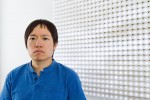This post was updated June 5 at 12:07 p.m.
Justin Lui’s optometrist switched his monthly disposable contact lenses to daily ones a few years ago.
The ensuing plastic waste inspired a multimedia project aimed to convey the importance of environmental sustainability.
Lui, a design media arts and architechture alumnus, spent more than three years creating “Poly-Mer,” a structure made primarily out of contact lens trays set in front of low-resolution videos of Southern Californian waves. Although his disposable lens trays are recyclable, Lui said the recycling process is never 100 percent efficient, contributing to the pileup of plastic waste in our oceans.
“With this piece, I’m not waving an (activism) placard necessarily, but hopefully it can inspire some thinking,” Lui said. “Hopefully it gives people pause to see what’s essentially here – this wasted material.”
The name of the project itself – “Poly-Mer” – refers to both the large polymer molecules that make up plastics as well as the French word “mer,” meaning “sea.” Lui said the name serves as a literary representation of the ocean’s relationship with plastic. Since the ocean is an integral part of our natural surroundings, highlighting its relationship with plastic can help people understand the importance of reducing plastic consumption, he said.
The ocean is also incorporated in the physical display of the project, as Lui’s own footage of Los Angeles and Santa Barbara beach waves are projected on a wall behind the gridlike structure of the contact lens trays. The trays are held in place by custom 3D printed holders, which also support the LED lights positioned behind each tray. By placing the trays directly in front of the LEDs, the light is disseminated to create a soft glow, he said.
“Using the trays in this way, to diffuse the light, is just one way he took this discarded material and transformed it into a beautiful object,” said Nikita Pashenkov, a technical designer and a friend of Lui’s who witnessed the project’s creation.
Pashenkov also said the LED bulbs, which create patterns of light behind the trays, allow the viewer to interact with the project by tracking the light’s wavelike movements.
Although Lui said his projects often have dynamic surfaces which incorporate a variety of elements such as light and space, “Poly-Mer” is the first time he needed such heavy technical support in order to coordinate the synchronized movement of the lights and the rolling footage in the background. Pashenkov, who gave Lui technical advice throughout the creative process, said adding electronic elements to the project proved to be a lot harder than expected.
“For (Lui), the project was like boiling the ocean,” Pashenkov said. “The handiwork that went into it involved connecting each light to a pair of wires connected to a control board.”
Lui utilized Pashenkov’s technical skill set along with the help of Gautam Rangan, a fellow design media arts alumnus who utilizes digital technology in his own designs. Because the video’s pixels are controlled through electronic software, Pashenkov and Rangan ran code to prevent the videos from glitching and help simulate the correct light movement patterns.
Lui said the heavy use of light and moving images represents our modern consumer-driven society which ultimately breeds excessive waste. He also said the distractions people face with technological advancement can cause them to sacrifice the thoughtfulness necessary in making environmentally friendly purchases. People don’t necessarily have bad intentions, he said, but simply aren’t aware of the waste they accumulate. Because daily communication now mainly occurs through a screen, he said he wanted to use a technological medium to stress the importance of both consumers and manufacturers in reducing waste.
Lui also purposely displayed his videos in low resolution to contrast with the high-quality graphics most people are accustomed to. Rangan said the lack of detail in the images allows viewers to focus only on the essential movements – the crashing of each wave.
“We live in a world nowadays where high-resolution video is pervasive everywhere – it’s on our TVs, on our computer screens, in our pockets, in our hands,” Lui said. “I’m deliberately going the other direction so the viewer can just focus on the movement.”
He said the simplification he achieved by rendering the videos in low resolution is a technique inspired by Jim Campbell, a San Francisco-based artist who’s known for scaling down images to bring about just the essence of the action. An emphasis on simple action served as a method for Lui to convey the small ways individuals can help combat pollution, Rangan said.
“The videos serve as a super explicit way for (Lui) to communicate his environmental message because it sheds light on the dynamic behavior of the ocean and of the different elements of nature, and through that, the dangers of polluting those elements with our waste,” Rangan said.
Lui said he hopes the interactive movements invoke an exciting experience for viewers, but he also hopes they serve their purpose in criticizing consumption habits and encouraging manufacturers to provide more sustainable choices.
“I think seeing this piece in person will give a lot of people delight, but I also want to inspire everyone to look at the current system of how we get our consumer goods,” Lui said. “Even trivial behavior like wearing daily contact lenses can have really harmful effects, and those consequences are seriously worth considering.”
